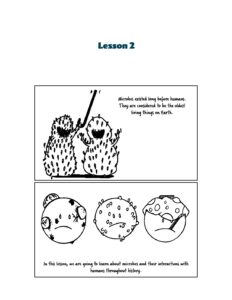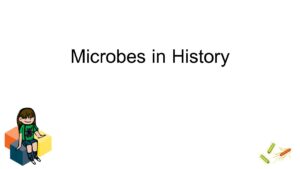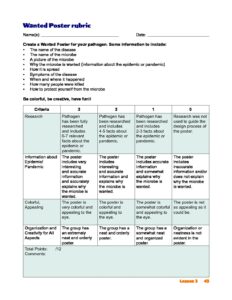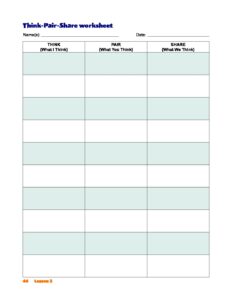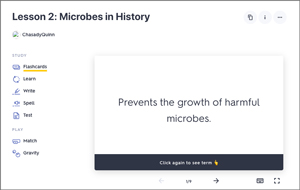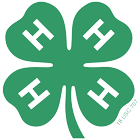Lesson 2: Microbes in History
Youth model a disease outbreak. They explore the Black Plague and other historic pandemics to learn how microbes have shaped human history.
Key Teaching Points
- Microbes can cause disease in human populations.
- An epidemic occurs when a disease or illness infects many more people than what was expected within a country or part of a country.
- A pandemic occurs when a disease or illness infects numerous people over a wider spread geographical area than an epidemic.
Learner Outcomes
- Develop a basic understanding that microbes have plagued human history throughout time.
Skill Level: 6-8th grade
Success Indicators
- Participants will understand the difference between a pandemic and an epidemic.
- Participants will create a Wanted Poster for a specific microbe that plagued the human population.
Life Skills
Teamwork, Disease prevention, Critical thinking
Time Needed
2 days, approximately 90-120 minutes in total
Space
Classroom or area where there is ample space for all participants
Suggested Group Size
Participants can create Wanted Posters in groups of 4-5, in pairs, or individually
Materials
Materials List
- Technology to present the presentation to the class
- Paper or poster for each participant • Access to computers or library for participant research
- Glo-germ
- Blacklight
- Colored pencils, markers, rulers, etc., for all participants or groups to complete their Wanted Posters
- Wanted Poster rubric (one per group/participant)
- Think-Pair-Share worksheet (one per participant)
Materials for Variations
- Zippered plastic bags full of orange-powdered puffed cheese snacks, 1 per participant OR glitter glue OR Glo-germ and a blacklight
- Plain white paper
- Colored pencils, markers, crayons, pens, etc.
- Youth handouts
Introduction
Introduction
Throughout history, many different microbes have plagued our earth. Bad microbes can cause large groups of people to become very sick when an outbreak occurs. When microbes affect huge groups of people, they cause epidemics and pandemics. An epidemic happens when the number of people infected by a microbe rises above the number that was generally expected. For example, if the flu is expected to infect 10,000 people and it infects 15,000 people, this would be an epidemic. When the numbers rise and occur across a larger region of land, such as in several countries, it becomes a pandemic. A pandemic occurs when an epidemic starts infecting even more people and humans have very little immunity to the microbe causing the disease. At this point, it is very easily transmissible or spread from human to human. Pandemics are even worse than epidemics! Many different microbes, such as those that cause influenza (flu) or the bubonic plague (Black Death) have had huge impacts on the world and society.
Before the Activity
- Choose one option for participant group size to conduct the Wanted Poster activity. This task can be accomplished by small groups of 4-5, pairs of participants, or individually.
- Prepare technology to show the presentation to the class.
- Set up stations for each group or individual to create a Poster.
- Arrange classroom or group supplies for easy access.
- Prepare copies of the Wanted Poster rubric for each group/participant.
- Prepare copies of the Think-Pair-Share worksheet for each participant.
- Conceal the blacklight somewhere in the room out of sight of the participants.
- Arrange for technology or print information to be available for participants to conduct research.
- Immediately before the class, pull three participants aside and have them rub Glo-germ on their hands.
- Direct all participants to walk back in and act as if nothing has happened. Make sure these particular participants do not share with others that they have the gel on their hands.
Part 1
Opening Questions
-
How do you think germs and diseases are spread?
-
What are some ways you think we can prevent diseases from spreading?
Part 1
- Ask the Opening Questions.
- Announce to the group that you want everybody to go around and shake hands with three people. Tell the participants once they have shaken hands with three people, they should sit down.
- Once all the participants have been seated, tell participants that we have influenza or the flu in our classroom and we had three people infected! We want to see if it has spread to others.
- Turn off the lights and turn on the blacklight.
- Each participant will observe their hands underneath the black light.
- After all participants inspect their hands, have the participants talk about the spread and who shook hands with whom. Have each participant trace from whom they think they were infected.
- At the end of the activity announce to the class who was infected to see if participants guessed the right people.
- ***Variation to this introduction activity: You can have each participant use an index card to identify with whom they shake hands. After the participants see their hands under the blacklight, they can discuss whose hands they shook and the commonalities.
- Show the presentation to the class.
Wanted Poster (Part 1, page 37 of the book)
- Introduce the Wanted Poster activity and direct participants either to small groups, pairs, or individual work.
- Participants will do a quick search on the Internet for facts and pictures of multiple types of microbes in history to gain a basic understanding. This should take no more than 5-10 minutes.
- After researching, the individual or groups will pick one microbe on which to focus. Each individual participant or group will create a Wanted Poster for an epidemic or pandemic that has plagued history. Some examples of illnesses caused by microbes are Smallpox, Influenza, The Black Death, Malaria, Tuberculosis, Cholera, Yellow Fever, and Polio.
- Provide a copy of the Wanted Poster rubric to each participant or group. Instruct the participants or groups to write their name(s) on the rubric.
- Read the rubric with the participants as necessary before they start. [Note: This rubric is just an example and not required. It may be modified for the facilitator’s needs.]
- Direct participants to use technology or print materials to research and create their Wanted Poster. A time limit may be imposed, and Posters may be completed during the second session if necessary (if the class will be divided). Or, the Poster may be assigned as out-of-class work and brought to the next session.
This is a good stopping point if the class will be divided into two sessions.
Remote Lesson Variation: Spread It!
-
Ask the Opening Questions.
-
-
How do you think germs and diseases are spread?
-
What are some ways you think we can prevent diseases from spreading?
-
-
Pull 2-3 students aside and cheese puff dust or glitter glue on the hand they will be shaking with.
-
Announce to the group that you want everybody to go around and shake hands with three people. Tell the participants once they have shaken hands with three people, they should sit down.
-
Once all the participants have been seated, tell participants that we have influenza or the flu in our classroom and we had three people infected! We want to see if it has spread to others.
-
Ask everyone to look down at their hands and look for signs it being spread to them (orange cheese puff dust or glitter glue on their hand) and have the ones infected, stand up.
-
At the end of the activity announce to the class who was infected to see if participants guessed the right people.
-
***Variation to this introduction activity: You can have each participant use an index card to identify with whom they shake hands. After the participants see their hands, they can discuss whose hands they shook and the commonalities.
-
-
Show the presentation to the class.
-
Have students read through the comic strip for this lesson found in the print materials.
(Continue with the Wanted Poster)
Remote Alternate Variation: Spread It!
-
Have students wash and dry their hands. One hand will be their “Snack” hand. The other hand will be their “Clean” hand.
-
Place a clean sheet of white paper on the table or counter where they are working.
-
Have them use one hand to reach into the bag of cheese snacks. This is their “Snack” hand. They can eat them or discard them at this time.
-
Next, have them place the palm of their “Snack” hand down on the white paper.
-
Have them remove their “Snack” hand from the paper. Ask “What do you notice?”
-
Have them place their “Clean” hand on top of the white paper where their “Snack” hand had been.
-
Have them remove their “Clean” hand from the paper. Ask “Is it still clean?”
-
Ask the Reflect questions:
-
How does this activity model the spread of microbes, including pathogens, across populations and spaces?
-
How might you improve this model?
-
Part 1 Assets
Part 2
PART 2
-
-
If participants have not finished their research or Wanted Posters, allow time at the beginning of this session as necessary.
-
Allow participants to share their Wanted Posters.
-
The class may vote on which microbe is the “Most Wanted.”
-
Provide a copy of the Think-Pair-Share worksheet to each participant.
-
Ask the Reflect questions and have participants consider them individually for three minutes.
-
Today, we realize that some microbes are extremely dangerous and can spread during epidemics and pandemics.
-
Why is it important that people study microbes and microorganisms?
-
How did we protect our bodies from microbes in the past versus how we protect our bodies today?
-
What has evolved or changed?
-
-
Direct participants to discuss their answers with a partner for three minutes and complete their Think-Pair-Share worksheet.
-
Conduct a whole-class discussion to finish the Think-Pair-Share activity.
-
Ask the Generalize questions.
-
Why is it important to study epidemics and pandemics?
-
What difference can humans make in preventing the spread of epidemics and pandemics?
-
Optional: As time allows, allow participants to complete the Apply activity.
Participants can do research into an epidemic or pandemic that has affected their region at some point in history. They should look up the statistics, research facts, and create a brochure for their local health department about this microbe that has infected their area. -
Variation
Along with creating a Wanted Poster, youth can do research on SARS-CoV-2 virus (the virus that causes COVID-19) and compare/contrast SARS-CoV-2 with their chosen microbe.
Part 2 Assets
Optional Part 3
Remote lesson: Plague and the Black Death
Have students learn more about what influenced the Black Death to spread with this Geoinquiry from Esri.
Variation: Operation: Outbreak!
People in medieval Europe did not know what caused the Black Plague to spread. Today, we understand diseases better thanks to the work of scientists, doctors, and epidemiologists (eh-pih-dee-mee-ah-uh-jists). Epidemiologists are specialized doctors who study the spread of diseases and try to stop the spread before diseases get out of control.
The CDC, 4-H, and the University of California have created Operation: Outbreak!, a curriculum to teach youth more about epidemiology. You can view materials here.

